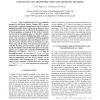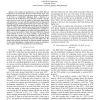1020 search results - page 195 / 204 » The Poisson Fading Channel |
SIPS
2007
IEEE
14 years 2 months ago
2007
IEEE
– Luby Transform codes (LT) were originally designed for the Binary Erasure Channel (BEC) encountered owing to randomly dropped packets in the statistical multiplexing aided clas...
INFOCOM
2003
IEEE
14 years 1 months ago
2003
IEEE
— We analyze the performance of the IEEE 802.11b wireless local area networks. We have observed that when some mobile hosts use a lower bit rate than the others, the performance ...
CORR
2007
Springer
13 years 7 months ago
2007
Springer
— We analyze the feasibility of distributed spatial multiplexing with limited feedback in a slow-fading interference network with MN non-cooperating single-antenna sources and M ...
TWC
2008
13 years 7 months ago
2008
Abstract--In a cellular distributed antenna system (DAS), distributed antenna elements (AEs) are connected to the base station via an offline dedicated link, e.g. fiber optics or l...
INFOCOM
2010
IEEE
13 years 6 months ago
2010
IEEE
—Generating a secret key between two parties by extracting the shared randomness in the wireless fading channel is an emerging area of research. Previous works focus mainly on si...


